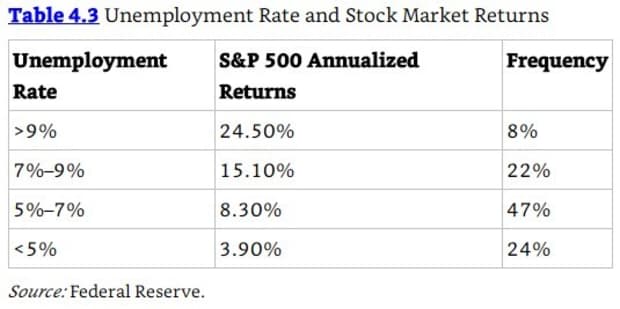Raise your hand if you knew, after the March crash, that the stock market would hit record highs by the end of the year. Stop. Put it down. Nobody believes you.
Even for the hardy “buy when there’s blood in the streets” crowd, throwing more money into the game when the pandemic was starting to explode and the world was spiraling toward economic disaster had to have seemed terrifying at the time.
Nevertheless, as Ben Carlson, portfolio manager at Ritholtz Wealth Management LLC, pointed out in a blog post on Sunday, “investing when things look bleak remains a profitable strategy.”
He pointed to this chart as evidence:

In other words, when unemployment is high, stocks soar, and when it’s low, gains are relatively paltry. At least that’s what history has told us.
“It’s counterintuitive that the best returns would come from investing when the economy is getting body-slammed,” Carlson wrote. “But being uncomfortable when investing is typically a good sign.”
He acknowledged that he felt, during the initial market drop, that stocks could potentially fall another 60% from there. In that four-week period that started in late February, stocks experienced the fastest bear market of 30% or worse from all-time highs in history. Yet, just five months later and stocks were again pushing up into uncharted territory.
“Just think about how many brilliant people decided to play it safe and wait for a retest of the lows after stocks bounced,” Carlson said. “Guess, what? By the time the dust settled it was already too late. The stock market proved a lot of people wrong this year.”
Of course, it was easy to be caught wrong-footed in the face of rising unemployment, mounting coronavirus death tolls and political unrest, but even so, the actions of the Federal Reserve, in retrospect, was where the focus should have been.
“The government threw trillions of dollars at this thing. They literally gave people money,” Carlson said. “It seems obvious now that those trillions and an implicit backing from the Fed would provide a floor under the markets. But few people at the time were predicting a rush back to all-time highs while these programs were being rolled out.”
The best way to navigate the madness? It’s hard to beat the buy-and-hold approach, he suggested, though sticking to it through a 30% peak-to-trough drop within a month wouldn’t have been easy. Then again, stocks have recovered 60% since then to make for a net 15% gain.
“Holding is difficult but it may be even harder to go one step further and buy when stocks are falling and everyone is running for the exits,” Carlson wrote. “Buy and hold only works if you both buy and hold when it feels like the market may never rise again.”
As for the major indexes, the Dow Jones Industrial Average DJIA,
